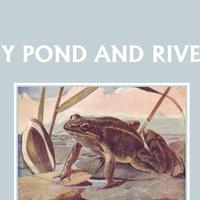CHAPTER 11. FLOWERS FOR THE SHOW
"WHERE are you going, Peggy?" asked Peter, as he passed her in the lane, one Saturday afternoon in July.
"I am going to look for flowers, for the flower-show next week. I shall not gather them, but I want to see what I can find." "May I go with you?" "Yes, if you can keep a secret. I want to make quite a new kind of nosegay, of flowers that grow in the water." "But they will all fade if you put them in a bunch." "I am not going to put them in a bunch. I am going to get one of father's large zinc pans which he uses for the dog's food, and let the plants float in the water." So Peggy and Peter started off to their favourite pond.
"See, Peter, I must have one of those lovely yellow 'water-lilies,' with its large, shiny green leaf, and one of its curious seed-boxes, which remain after the yellow flower-leaves have fallen off. I know that this plant has a thick stem in the mud at the bottom of the pond, and the long stalks grow right up, so that the leaves float on the top of the water. Little beetles crawl inside the flower and get honey from under the small yellow flower-leaves inside.
"Then I must have some of those white stars with yellow in the middle. They look so pretty among their small green leaves, which are cut into three half-rounds. That is the 'water-crow-foot,' and if you hook a bit in with your stick we shall see that it has some other leaves under water, which are cut into strips like fine blades of grass." "Why should it have two kinds of leaves, Peggy?" "One set are its floating leaves to keep the flowers above the water, where the insects can get at them, and the others are lighter and can spread out in the water without making so much green leaf. And look, Peter, the yellow lines on the white flowers point straight to the narrow end of the flower-leaf, where the insects find the honey.
"Then I must have some duckweed. It will cover the pan so nicely." "But the duckweed is not pretty, Peggy. It is all leaves." "No, Peter, that is just what it is not . Paul told me the other day that the duckweed has no real leaves. Each plant is a little bit of stem with a thin root hanging down in the water. Very tiny flowers sometimes grow in a little split in the side of the stem. I shall try to get one of these, but they are so very small, and are only made of two little dust-bags and a seed-box. But the duckweed will float on the water.
"Now, Peter, I want to find a 'bog-bean' in flower. I am afraid it is rather late in the year, but there are some, I know, at the shallow end of the pond. You must look for a large spike of pink-white flowers, shaped something like wide blue-bells and lined with a number of white hairs. Ah! Here is one with the buds just opening; it will be all right for Wednesday.
"Now we must have one more. A little plant called the 'water-milfoil,' which is almost all under water, except the spike of tiny pink flowers which stands straight up in the air. Look at its fine leaves arranged in stars round the stem. They lie out so well in the water. If you look very carefully at the flowers, you will see that the top ones have only dust-bags in them, and the lower ones have only seed-boxes. But they are so small it is not easy to see this.
"Now I must not choose any more, for I must describe each one on my show-card, and it will take a long time.

